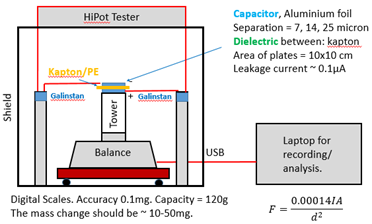For the past five months my Chief Engineer (Richard Arundal) and myself have been busy in the lab attempting to prove that one can extract propellant-less thrust from a capacitor by using quantised inertia. QI thrust is implied theoretically (McCulloch, 2013, 2017), but a capacitor approach was first suggested and tested by Becker and Bhatt (2018) who had read my paper on thrust and dielectrics (2017) and did some lab tests in liaison with me. Their work has been seconded by Mansell/IVO Ltd.
Curious to test this approach I used the last remaining DARPA money to set up a lab at Plymouth University, hiring Richard. What we now have in the lab is shown above, with a few details withheld for IP reasons. The capacitor (blue plates with orange dielectric) is placed on an insulating tower on a digital balance on a heavy damping plate. The capacitor is charged up to 5 kV with a HiPot tester (on top) via wires that pass their current through Galinstan, a cool liquid metal that breaks the physical connection to the outside world and allows the capacitor to ‘float free’ on the balance.
For the past month we have been struggling with an unwanted electrostatic
force, but we noticed an asymmetry as we flipped the capacitor. Recently I
have looked at all the data and used maths (including matrix algebra, that I always wanted to use for something useful!) to separate
out the EM force from the asymmetrical one. This extracted force is towards the
anode and looks like QI. It is about 10 milligrams, only 1/3 of the force
predicted (McCulloch, 2021) but there are good reasons why that might be, and
we will now look at those.
In short, unless we can think of another effect that could
cause a force towards the anode, then we have it and the transport & energy
industry will never be the same.
References
Becker, F.M. and A.S. Bhatt,
2018. Electrostatic accelerated electrons within symmetric capacitors during
field emission condition events exert bidirectional propellant-less thrust.
Arxiv: https://arxiv.org/abs/1810.04368
McCulloch, M.E., 2013. Inertia from
an asymmetric Casimir effect. EPL, 101, 59001. https://arxiv.org/abs/1302.2775
McCulloch, M.E., 2017. Testing
quantised inertia on emdrives with dielectrics. EPL, 118, 34003. https://iopscience.iop.org/article/10.1209/0295-5075/118/34003

11 comments:
It is extraordinary that 1/3 was obtained considering what Richard had to work with. Fabricating a capacitor with Kapton dielectric, uneven gap, imperceptible current leakage or breakthrough...
1/3 is a triumph!
Still watching with high interest!
Keep the excitement coming, please!
(IANAPhysicist, just someone interested in QI)
Have you accounted for any possible radiation pressure?
Bob: Yes. I estimate the maximum radiation pressure to be 0.03 mg.
exciting
Mike, could there be any surface tension effect between the wires and the Galinstan?
Hi Mike:
(1/3) is great efficiency for a proof-of-concept experiment! Congratulations!
George
Mike,
Is the power the leakage current times the voltage?
Mike - A friend of mine suggested using Parylene coating as the dielectric. This can give you sub-micron pinhole-free layers - see https://parylene.co.uk/applications/electronics/ for someone in the UK who will do the coating. Dielectric strength is stated as 6-7kV/mil, which if I've got the sums right works out to 236-275V/micron, thus a bit better than Kapton. Possibly either deposit Silver on this layer (mirror process) for the counter-electrode or use some conductive Oxide powder to restrict current flow when the dielectric fails, as suggested earlier. Handling sub-micron sheets of dielectric would be very hard, but if you can get the coating directly on the metal it becomes a lot easier.
So far here no joy with using anodised metals (dielectric layer in the 20nm range) to produce thrust. Could be that the transit of electrons through a polymer layer is different than through an oxide layer, and you need the polymer to get a thrust. Also could be the conductive oxide layer of around 1mm doesn't give the same effect on Unruh waves as a full conductor would.
I've been following your work with interest. Will you name the first QI starship after my girl Sloopy?
Hi Mike,
have you considered testing the device outdoors? I did read somewhere on the blog or at the youtube channel that a sheet metal above or below the anode or kathode can make a difference; it might affect the measured force as the building itself and its incorporated metal could interfere. But then I could easily have misremembered or barking up the wrong tree.
Post a Comment